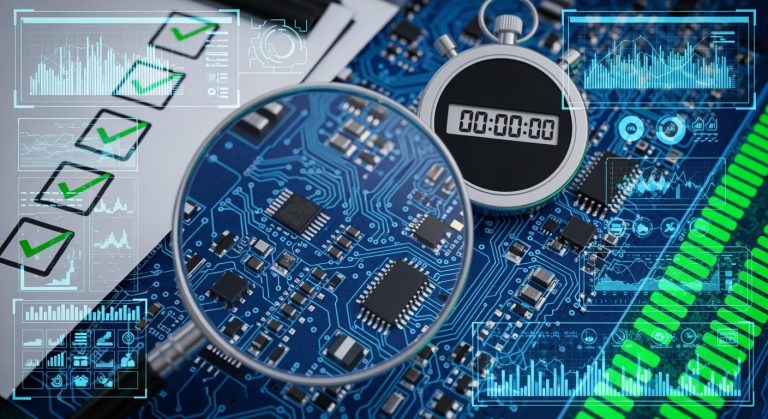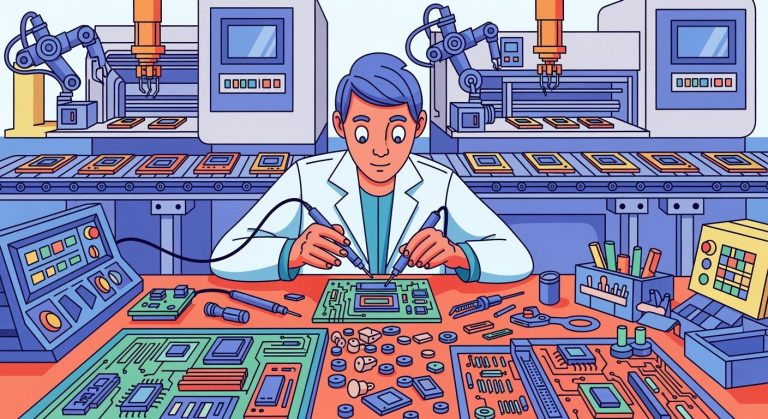The Role of PCBs in Advancing Brain–computer interface Technology
You rely on PCBs to bring brain-machine interface systems to life. These intricate boards serve as the backbone, ensuring precise communication between the brain and external devices. By handling complex signal processing, they transform neural impulses into actionable outputs. PCBs also enable miniaturization, making wearable or implantable brain devices practical. Their reliability ensures consistent performance in these sensitive applications. A Brain interface PCB must meet exacting standards to function seamlessly in such critical systems. Without PCBs, advancing brain-machine technology would be nearly impossible.
Key Takeaways
- PCBs are key for brain-machine links, helping brains talk to devices.
- Smaller PCBs make wearable and implantable devices more comfy and useful.
- Better PCB materials are safer for the body and last longer.
- Adding AI to PCBs makes signals clearer and brain-device work smoother.
- New PCB designs aim to be safer and lower health risks.
Understanding Brain Interface PCBs
What Are PCBs in Brain-Machine Interfaces?
Printed circuit boards (PCBs) are the foundational components that enable the functionality of brain-machine interfaces (BMIs). These intricate boards serve as the platform for connecting and integrating various electronic components, such as neuromorphic chips, sensors, and amplifiers. In BMIs, PCBs facilitate the seamless communication between the brain and external devices by processing neural signals and transmitting them to the appropriate output systems.
Advancements in PCB technology have revolutionized neurotechnology. For instance, printable electronics now allow for rapid prototyping and scalability, making it easier to develop devices like microelectrode arrays (MEAs) and electrocorticography (ECoG) arrays. These tools are essential for recording and stimulating neuronal activity. Additionally, the use of biocompatible and flexible materials in PCB design enhances their compatibility with the human body, enabling long-term monitoring and interaction with the brain.
PCBs like the Zynq2Neuro (Z2N) are specifically designed to manage neuromorphic hardware. These boards play a critical role in processing neural signals, ensuring that BMIs can interpret and respond to brain activity accurately. By integrating bioelectronics with biological systems, PCBs also support applications like drug delivery and physiological monitoring, further expanding their impact on health and neurodevelopment.
General Functions of PCBs in Brain-Computer Interfaces
In brain-computer interfaces (BCIs), PCBs perform several essential functions that ensure the system operates efficiently. First, they handle signal acquisition and processing. For example, PCBs equipped with preamplifiers and application-specific integrated circuits (ASICs) can process signals from up to 48 input channels with minimal noise. This capability is crucial for capturing high-resolution brain activity data.
Second, PCBs enable data transmission and communication. Many modern PCBs support wireless communication at frequencies like 2.7 GHz, allowing for low-power, high-speed data transfer. This feature is particularly important for wearable or implantable BCIs, where minimizing power consumption is critical.
Third, PCBs support sensor integration and configurability. They can connect to various sensors, such as EEG electrodes, to monitor brain activity and map bio-signals like ECG and EMG to specific outputs. This versatility makes PCBs indispensable for applications ranging from health monitoring to neurodevelopmental research.
Finally, PCBs enhance the reliability and stability of BCIs. By using advanced materials and designs, they ensure consistent performance even in challenging environments. For instance, flexible sensors integrated into PCBs can conform to the brain’s surface, enabling long-term monitoring without causing discomfort or damage.
Key Contributions of PCBs to Brain-Machine Interface Systems
Signal Transmission and Processing in Brain Interfaces
PCBs play a pivotal role in ensuring accurate signal transmission and processing within brain-machine interfaces. These systems rely on the seamless conversion of neural signals into actionable data. You can think of PCBs as the communication hub, where signals from the brain are amplified, filtered, and transmitted to external devices. This process demands precision, as even minor distortions can compromise the system’s functionality.
For example, the g.Pangolin system demonstrates how advanced PCB designs enhance signal quality. This ultra-high-density EEG system uses flexible PCBs with gold-plated electrode areas to ensure optimal conductivity. The diamond-shaped electrodes conform to human skin, reducing impedance and improving signal clarity. A pre-amplifier with a fixed gain of 10 further boosts signal quality, ensuring a high signal-to-noise ratio (SNR). The slim socket connector links the electrode grid to the biosignal amplifier, maintaining efficient data flow. These features highlight how PCBs optimize signal processing in brain interfaces.
| Feature | Description |
|---|---|
| System Name | g.Pangolin |
| Type | Ultra-high-density EEG system |
| Electrode Production | Flexible printed circuit boards (PCBs) with gold-plated electrode areas |
| Electrode Geometry | Diamond-shaped, designed to conform to human skin |
| Inter-electrode Distance | 8.6 mm |
| Electrode Diameter | 5.9 mm |
| Adhesive Layer | Moisture-resistant and insulating materials to prevent shortcuts and crosstalk |
| Conductive Adhesive Paste | Used to ensure optimal skin contact and low impedance at the electrode-skin junction |
| Signal Amplification | Pre-amplifier with a fixed gain of 10, improving signal quality and SNR |
| Connection | Slim socket connector linking electrode grid to pre-amplifier and biosignal amplifier |
By integrating such advanced mechanisms, PCBs ensure that brain-machine interfaces deliver reliable and accurate performance.
Miniaturization for Wearable and Implantable Brain Devices
Miniaturization is a game-changer for wearable and implantable brain devices. PCBs enable this transformation by integrating multiple layers of circuitry into compact designs. This innovation allows you to wear or implant devices without compromising comfort or functionality. Smaller PCBs also reduce power consumption, making these devices more efficient.
Studies have shown that multilayered PCBs in lightweight EEG earbuds significantly improve performance. These devices minimize motion artifacts and enhance signal quality, enabling continuous EEG recording during activities like walking or exercising. This advancement underscores how miniaturized PCBs make brain-machine interfaces more practical for everyday use.
The multilayered PCB in the lightweight EEG earbud significantly enhances performance by minimizing motion artifacts and improving signal quality, allowing for continuous EEG recording during various activities.
By focusing on miniaturization, PCBs pave the way for more accessible and user-friendly brain-machine technologies.
Reliability and Stability in Brain-Machine Applications
Reliability and stability are non-negotiable in brain-machine applications. PCBs must perform consistently under challenging conditions, including exposure to moisture, temperature fluctuations, and electromagnetic interference. Advanced materials and designs ensure that PCBs meet these demands.
Flexible PCBs, for instance, can conform to the brain’s surface, providing long-term stability without causing discomfort. Moisture-resistant layers and insulating materials prevent shortcuts and crosstalk, ensuring uninterrupted performance. These features make PCBs indispensable for applications like health monitoring and neurodevelopmental research.
You can trust PCBs to deliver the reliability needed for critical brain-machine systems. Their robust design ensures that these systems operate seamlessly, even in demanding environments.
Challenges in Designing Brain Interface PCBs
Addressing Design Complexities for Precision
Designing PCBs for brain-machine interfaces involves intricate challenges. You must ensure precision in signal acquisition and processing while maintaining the compactness of the device. For example, integrating EEG acquisition systems with FPGA technology enhances performance and scalability. However, achieving precise data acquisition and event synchronization during dynamic conditions remains a significant hurdle. Modern microelectronics and FPGA advancements have improved throughput, but the complexity of these systems demands meticulous design.
Trade-offs are inevitable in PCB development. Increasing electrode counts improves data quality but adds to power consumption and size. Similarly, higher sampling frequencies enhance resolution but require more power and data throughput. Balancing these factors is critical to achieving high-resolution real-time monitoring and effective electrical stimulation. These complexities highlight the need for innovative approaches to PCB design.
Managing Heat and Electromagnetic Interference
Heat and electromagnetic interference (EMI) pose significant challenges in PCB performance. High-speed circuits, especially those using Multi-Layer Ceramic Capacitors (MLCCs), are highly sensitive to connection inductance. This can degrade circuit performance, impacting the reliability of brain systems. EMI further complicates matters by causing signal degradation or complete data loss, particularly as clock speeds increase to enhance chip performance.
To mitigate these issues, you can adopt advanced design techniques. Decoupling capacitance options, for instance, can reduce EMI emissions and maintain signal integrity. Additionally, thermal management mechanisms, such as heat sinks and thermal vias, help dissipate heat effectively. These strategies ensure that PCBs operate reliably in demanding brain-machine applications.
Overcoming Material and Biocompatibility Constraints
Material selection is critical for ensuring the biocompatibility of PCBs in brain-machine interfaces. Porous alumina, for instance, has proven biocompatible with neuronal cells, with larger pore pitches improving cell adhesion. Solder masks also show no cytotoxic effects on retinal cultures, making them suitable substrates for microelectrode arrays. However, some materials negatively affect cell functions, requiring careful evaluation during the design process.
The use of flexible and biocompatible materials enhances the compatibility of PCBs with the human body. These materials conform to the brain’s surface, enabling long-term monitoring without causing discomfort or damage. By addressing material constraints, you can ensure that PCBs meet the stringent requirements of brain-machine interfaces while supporting neurodevelopmental research and health monitoring.
Innovations in PCB Technology for Brain-Computer Interfaces
Flexible and Biocompatible PCB Materials
Advancements in flexible and biocompatible materials have transformed the design and functionality of PCBs in brain-computer interfaces. These materials allow PCBs to conform to the brain’s surface, ensuring seamless integration with biological tissues. This flexibility reduces the risk of neurotoxicity and enhances the long-term stability of devices used for neurodevelopmental monitoring and health applications.
Several cutting-edge materials have emerged as game-changers in this domain:
- Lignocellulose nanofibrils (LCNF): Derived from a biorefinery process, LCNF retains natural bonding to lignin, which enhances substrate fabrication. Experimental studies highlight its strong mechanical and electrochemical properties, making it ideal for sustainable PCB development. A practical example includes the creation of a computer mouse using LCNF, showcasing its potential in eco-friendly electronics.
- Graphene: Known for its exceptional electrical and thermal conductivity, graphene offers remarkable mechanical flexibility. This makes it a preferred choice for thinner and lighter PCB designs, particularly in wearable and implantable brain devices.
- Conductive polymers: These materials revolutionize flexible electronics with their low-temperature processability and adaptability. They are particularly suitable for medical applications, where comfort and precision are paramount.
- Advanced composites: By combining ceramics or nano-fillers with traditional substrates, these composites enhance thermal stability and mechanical resilience, ensuring reliable performance in demanding environments.
The integration of these materials into PCBs not only improves their biocompatibility but also supports the development of devices that can withstand developmental exposure to challenging conditions. This innovation is crucial for advancing bioelectronics and ensuring the safety and effectiveness of brain-machine interfaces.
High-Density Interconnect (HDI) PCBs for Brain Applications
High-density interconnect (HDI) PCBs represent a significant leap forward in the design of brain interface PCBs. These advanced boards enable the integration of multiple layers of circuitry within a compact footprint, making them indispensable for applications requiring high precision and miniaturization.
HDI technology has proven particularly effective in the development of high-density microelectrode arrays. These arrays enhance spatial resolution and enable the collection of neural data across multiple brain regions. For example, the Layer 7 Cortical Interface demonstrates how HDI PCBs can deliver effective neural recording and stimulation capabilities. This innovation promises improved decoding and encoding of neural signals, paving the way for more sophisticated brain-computer interfaces.
| Feature | Benefit |
|---|---|
| High-density microelectrode arrays | Improved spatial resolution and neural data collection |
| Minimally invasive techniques | Safe implantation of over 2,000 microelectrodes without craniotomy |
| Layer 7 Cortical Interface | Enhanced neural signal decoding and encoding capabilities |
By leveraging HDI technology, you can create PCBs that meet the stringent requirements of brain-machine systems. These boards ensure reliable performance while minimizing the risks associated with developmental neurotoxicity and prenatal exposure to environmental contaminants.
Integration of PCBs with AI and Machine Learning in Brain Systems
The integration of PCBs with artificial intelligence (AI) and machine learning (ML) has unlocked new possibilities for brain-computer interfaces. These technologies enhance the ability of PCBs to process and interpret complex neural signals, enabling more accurate and efficient brain-machine interactions.
AI-driven algorithms can analyze data collected by PCBs in real-time, identifying patterns and predicting outcomes with unprecedented accuracy. For instance, machine learning models can optimize the performance of EEG systems by reducing noise and improving signal clarity. This capability is particularly valuable for applications in neurodevelopmental research and health monitoring.
Moreover, the combination of AI and PCBs supports the development of adaptive brain-machine interfaces. These systems can learn from user behavior and adjust their functionality accordingly, ensuring a personalized and intuitive experience. This innovation not only improves the usability of brain-computer interfaces but also expands their potential applications in fields such as rehabilitation, cognitive enhancement, and bioelectronics.
By integrating AI and ML with PCBs, you can harness the full potential of brain-machine technology. This synergy promises to revolutionize the way we interact with machines, offering new opportunities for improving health and advancing neurodevelopmental research.
The Future of Brain Interface PCBs
Emerging Trends in PCB Design for Brain-Machine Interfaces
You are witnessing a transformative era in PCB design for brain-machine interfaces. Emerging trends focus on improving biocompatibility, miniaturization, and manufacturing efficiency. These advancements aim to enhance device integration while minimizing neurotoxicity and immune responses.
| Emerging Trend | Description |
|---|---|
| Advanced Materials | Use of biocompatible thin-film materials like polyimide to reduce immune response. |
| Flexible Probes | Development of thin, flexible multielectrode polymer probes to reduce tissue displacement. |
| High-Density Electronics | Integration of low-power, high-density electronics for efficient signal acquisition. |
| Robotic Insertion | Robotic approaches for precise insertion of flexible probes across multiple brain regions. |
| Microfabrication Techniques | Wafer-level microfabrication for high-throughput production of devices with a high channel count. |
These innovations address challenges like developmental exposure to environmental factors and prenatal exposure to persistent organic pollutants. By adopting these trends, you can expect PCBs to deliver safer and more effective brain-machine interfaces.
Enhancing Human-Machine Interaction Through Advanced PCBs
Advanced PCBs are redefining how you interact with machines. They enable seamless communication between the brain and external devices, improving usability and functionality. Future designs will focus on integrating advanced sensors, processors, and flexible materials to enhance adaptability.
📈 Market Insights: The PCB market, valued at $67.9 billion in 2023, is projected to reach $92.4 billion by 2029, growing at a CAGR of 5.4%. This growth reflects the increasing demand for high-performance PCBs in BCIs.
Key performance metrics expected to improve include:
- Integration of advanced sensors and processors.
- Coordination between sensing, processing, and actuation.
- Adoption of flexible and rigid-flex PCBs for better adaptability.
These advancements will reduce neurotoxicity risks and improve health monitoring, making BCIs more accessible for neurodevelopmental applications.
King Field PCB’s Role in Driving Innovation in Brain-Computer Interfaces
King Field PCB is at the forefront of innovation in brain-computer interfaces. By leveraging flexible printed circuit boards (fPCBs), they enable minimally invasive interfaces like wireless transcranial optogenetic platforms. These designs simplify manufacturing and support scalable distribution, ensuring widespread adoption.
Their multilayer copper-polymer fPCBs enhance device layout and serve as substrates for advanced bioelectronics. This approach facilitates the development of BCIs that prioritize safety, reliability, and long-term monitoring. King Field PCB’s commitment to innovation ensures that you benefit from cutting-edge solutions in neurodevelopment and health applications.
PCBs are the cornerstone of brain-machine interface systems, enabling seamless communication between the brain and external devices. Their compact structure integrates multiple electronic boards and batteries, driving miniaturization in brain applications. Advanced signal processing mechanisms, such as Multichannel-Baseline-Extraction Decomposition (MBED), eliminate redundant baseline variations, ensuring efficient neural recording. These innovations reduce developmental exposure risks while enhancing cognitive monitoring and neurodevelopmental research.
By addressing challenges like developmental neurotoxicity and prenatal exposure, PCBs safeguard human health risks in critical applications. Their role in visual and auditory BCIs highlights their potential to revolutionize cognitive systems. As PCB technology evolves, it promises to redefine health monitoring and expand the possibilities of brain-machine interfaces.
FAQ
1. What makes PCBs essential for brain-machine interfaces?
PCBs enable precise signal processing and seamless communication between the brain and external devices. Their compact design supports miniaturization, making wearable and implantable devices practical. Advanced materials ensure reliability and biocompatibility, which are critical for long-term use in neurotechnology.
2. How do flexible PCBs improve brain-machine interface systems?
Flexible PCBs conform to biological tissues, reducing discomfort and enhancing stability. Their adaptability allows for better integration with the brain’s surface, ensuring accurate neural signal recording and stimulation. This innovation supports applications like health monitoring and neurodevelopmental research.
3. What challenges arise in designing PCBs for brain-machine interfaces?
Designing PCBs involves balancing precision, compactness, and biocompatibility. Heat management and electromagnetic interference require advanced techniques. Material selection must ensure safety and compatibility with biological systems, especially for long-term use in sensitive environments.
4. Can PCBs be integrated with AI for brain-machine interfaces?
Yes, PCBs integrated with AI enhance signal processing and pattern recognition. AI-driven algorithms optimize neural data interpretation, improving accuracy and efficiency. This synergy supports adaptive systems for personalized applications like rehabilitation and cognitive enhancement.
5. What future trends will shape PCB technology in brain-machine interfaces?
Emerging trends include biocompatible materials, high-density electronics, and robotic insertion techniques. These innovations aim to improve device integration, reduce immune responses, and enhance manufacturing efficiency. They promise safer and more effective brain-machine systems.



















